Immersing your feet in a tub of warm water, even without anything extra in it, is a nice way to relax after a long day. A foot soak soothes your muscles, hydrates your skin, and can relieve aches and pains due to standing for hours or walking in uncomfortable shoes. Plus, letting your feet sit in their own bath can help reduce swelling and prevent bacteria from settling into blisters and cuts or under toe nails.
And while a little rough skin helps protect our feet, if you’re prone to developing thick calluses, softening them in a soak makes them easier to exfoliate – precisely the reason why most pedicures begin by submerging your feet into warm water.
There are some additions, however, that can enhance your healing foot soak.
Epsom Salt Foot Soaks
A combination of magnesium and sulfate, Epsom salt is a compound that can help flush toxins and heavy metals from your skin’s cells, reduce inflammation, increase circulation and ease muscle cramps and joint pain.
As your feet absorb the magnesium, pain-reducing ions are released, relaxing your muscles and nerves and helping them function properly by regulating your electrolyte levels. The sulfate targets any harmful substances that need to be eliminated from your body. Epsom salt can also quell foot odor, help heal fungus or ingrown nails, and soothe dry skin.
You’ll find this healing salt at most drug stores and pharmacies. In a standard size tub, dissolve one cup of Epsom salt in warm water and soak your feet for 10 to 15 minutes.
Essential Oil Soaks
There are several ways to use essential oils at home, including adding a few drops to your soak. Here are some popular choices, which you can use individually or combine together for your healing foot treatment:
- Cedarwood oil is an antiseptic and anti-fungal, making it a good choice if you suffer from Athlete’s Foot
- Cypress oil is an antiseptic and natural deodorant. Add a few drops to your soak if you have a blister or are concerned about foot odor.
- Juniper berry oil alleviates muscle aches, including those caused by arthritis.
- Lavender oil, as you may know, is a favorite for relaxation. It’s also a natural pain reliever—optimal for sore muscles and joints.
- Rosemary oil helps soothe tired muscles and has antiseptic properties.
- Wintergreen oil is considered nature’s aspirin. It helps with pain and swelling and has a cooling sensation that is particularly pleasurable on tired feet.
Consider adding a teaspoon of baking soda, vegetable oil to better incorporate the essential oil into the water. After soaking your feet for 10 to 15 minutes, dry them well to avoid an oily residue. Finish with a self-massage using lotion, locking in moisture and softening calluses. Try adding essential oils to your Epsom salt soak too.
When a soak isn’t enough
While foot soaks can be relaxing at-home treatments that effectively relieve minor aches and pains, it’s important to know when to see a doctor. Make an appointment if you experience any of the following signs:
• Sudden, severe foot pain
• Bleeding, bruising or tenderness following a foot injury
• Redness or swelling
• Foot pain if you’re a diagnosed diabetic
• Pain that lasts longer than seven days


